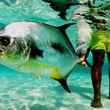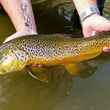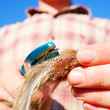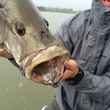My buddy Jock and I stood on the deck of a flats skiff, fresh off a short run from the lodge we were staying at in the Bahamas. We were facing down an enviable dilemma. About 50 feet away, a giant school of bonefish — hundreds of them — balled together in a “mud,” where they were busy gobbling up shrimp and crabs from the bottom of the blond, sand flat. If we were to cast, it would be like shooting fish in a barrel.
But both of us were hesitant. On the fringes of the school, about a dozen sizable nurse sharks and lemon sharks lay in wait. Should a zealous bonefish get too close to the edge of the mud the fish were stirring up, an opportunistic shark would be there to grab it. And, if we cast a Gotcha into the fray, and it got eaten, there was a really good chance that the hooked bonefish would be eaten, too.
“I don’t think I can do this,” I told our guide, who was clearly a bit out of sorts that the sharks were corralling the giant school of bones. He nodded, and understood. Sharks are protected in the Bahamas, one of the most progressive countries in the Caribbean. The predators are favorites among the dive crowd, and the government prohibits intentionally targeting sharks, even on a catch-and-release basis.
Truth be told, this has likely emboldened the toothy fish, and I have no doubt that sharks can be taught that, when anglers are around, there might be bonefish to be eaten. We’ve conditioned the predators, and, too often, we don’t exercise enough restraint when both bonefish and sharks are both around. The result often comes to hand as an 8-pound bone bitten cleanly in half, or simply a sliced leader and a swallowed fish.
“Throw a popper in there,” he said. “There’s a couple of decent jacks in there, and they might eat on top.”
I didn’t have a popper handy, but I did have a big, red Gurgler on the “cuda rod,” an 8-weight we kept strung up with wire leader, just in case we came across a mean-as-a-snake barracuda while we hunted bones on the flats. I pointed at the rod and looked at our guide.
“That’ll work,” he said, sliding the boat’s stern to give me the best angle from which to cast the Gurgler into the fray.
I stretched some line out, failing to make the connection — clearly, anything that ate the Gurgler would still have to run the sharky gauntlet, be it a middling jack crevalle or a big Bahamian bonefish. I guess that goes to show you that we prioritize the existence of some fish more than others, which is sort of silly. Honestly, if I had to pick between hunting 8-pound bonefish or casting to 20-pound jacks, I’d almost certainly pick the latter every single time.
I flipped the Gurgler into the fray and gave it a quick tug. It did exactly what it was supposed to do. There may not be a more aptly named fly than Jack Gartside’s attention-grabbing Gurgler.
I twitched the fly again, expecting a nice jack to jump on the Gurgler.. Instead, one of the nurse sharks on the edge of the mud charged the little fly, and before I could lift the fly out of the water, its jaws opened and it grabbed the Gurgler.
“Oh, Jesus,” I heard Jock mutter from the deck of the skiff. “What have you gotten us into now?”
The shark, stung by the heavy, wire hook, sprinted off toward Chub Cay, peeling line from the reel — I was reminded of Capt. Quint sitting in the fighting chair as a massive great white just kept taking line from the big-game reel as it sprinted toward Nantucket off the stern of the Orca.
We quickly threw the motor in gear, and off we went in pursuit. Honestly, I wasn’t as interested in catching up with the shark as I was at getting my fly line back. The butt end of the line had disappeared through the rod’s tip-top within seconds of the shark grabbing the fly, and I was watching with some anxiety as my backing was quickly expiring.
Long story short, we caught up with the shark and I reeled in enough line to where our guide could grab the leader and try to work the fly out of the shark’s jaws with a set of pliers. In a bout of good luck, just as soon as the guide touched the leader, the foam Gurgler flipped out of the shark's mouth.
“That’s a caught fish,” he said. I, of course, was absolutely thrilled with the idea that I’d managed to “catch” a nurse shark on a Gurgler (and I was relieved that I’d also managed to retrieve my $120 fly line). When I got a look at the Gurgler, it was pretty chewed up. And, not surprisingly, the hook was significantly less hooky after a few minutes of being gnawed on by a shark.
From the mind of a fish bum
Gartside might have been one of fly fishing’s original fish bums. I’ve heard stories of him tying flies atop the steering wheel of his Boston cab while he waited for a fare. He worked the cab-driver gig in fits and starts — usually, he’d drive the cab just long enough to save up enough money to drive west to Montana for the summer in the late 1970s and early 1980s, where he’d stay and fly fish until his money ran out. Then, he’d zip back to Boston in time for the fall striper run.
Gartside was an accomplished fly tyer — he’s credited with crafting dozens of unique patterns for both fresh and saltwater game fish. But his reputation as a legendary fly tyer is inextricably tied to the Gurgler.
Crafted with high-floating foam and a “lip” that pushes water on the retrieve, the Gurgler is the popper that just about anybody can tie. Not only is tying it fairly easy, but it’s one of those flies that lends itself to various additions and subtractions. I can be as simple as you like, or, with the addition of spun deer hair or some flash here and there, you can turn the Gurgler into a real project at the vise.
It makes sense that a guy like Gartside, who died in December 2009, would come up with a fly like the Gurgler. Back when he crafted it, tying with foam was a bit indecorous. Artificial and synthetic tying materials weren’t really a thing, and I’d wager that many of Gartside’s contemporaries frowned upon the idea of using craft foam in a fly pattern. But the foam did exactly what it was supposed to do, and it definitely added expedience at the vise. When time was short, a few foam Gurglers could be crafted in less than an hour, which meant Gartside could be wandering the flats for stripers after a day spent driving the cab.
But Gartside, who took his first fly-tying lesson from Ted Williams, the legendary Red Sox outfielder and equally accomplished fly fisher, was ever the innovator. Even though he’s been gone for 15 years, his fly patterns live on — it was his wish that, after he passed, his website be available for anglers and fly-tyers so they could emulate his work and perhaps even expand upon it.
If you’re an aspiring fly tyer, Gartside’s work is requisite. Simple as that.
A fly for all fish?
The Gurgler might not catch every fish, but, damn, it sure does catch a lot of fish. In the years since I discovered Gartside’s creation and started tying it and several variations of it, I’ve managed to bring to hand everything from northern pike to barracuda. I’ve even caught silver salmon, Dolly Varden and tiger trout on Gurgler patterns.
Why is it so effective?
Well, the answer is nuanced. First, it’s not always effective — it’s a fly for specific situations, when predatory fish are juiced up for one reason or another. The Gurgler moves water and acts a lot like a struggling baitfish. In the salt, the Gurgler’s movements are a dinner bell for striped bass, blue-water tuna and dorado and, of course, sharks, barracudas and those wonderful jack crevalle.
In freshwater, the same generally applies. Just after the spring spawn, when both largemouth and smallmouth bass are done defending their nests, the Gurgler is a great searching pattern.
It’s also maybe the best pattern for early-summer pike that are cruising shallow shoals or weed beds looking for prey. Skittered across the surface, the Gurgler makes a hell of a racket, and pike just can’t seem to resist it.
During the fall salmon runs in Southeast Alaska, aggressive pink and coho salmon will actively go after bright pink and orange Gurglers. Upstream, over deeper pools where the salmon will stop to rest, stripping a bright chartreuse or orange Gurgler over the pool will often cause a Dolly Varden to rocket from the depths in pursuit.
A couple of years ago in Patagonia, I tied up a poor-man’s version of the Moorish Mouse (which is, in fact, an offshoot from the Gurgler family tree), and the big browns of Chile’s Rio Blanco went nuts for it.
It’s a sight thing
Easily the best asset a Gurgler possesses is that, when it does get eaten, there’s almost always some drama. A top-water eat is the ultimate rush for most fly fishers, and watching something big and toothy come clear out of the water to grab a fly is quite the thrill.
And every shoestring relative of the Gurgler … every distant third cousin, like the Moorish Mouse, for instance, possesses that same trait. It moves water, struggles on the surface and elicits violent strikes from hungry fish, whatever their pedigree.
And, these days, with aging eyes and a bit more time to spend at the vise, I’m working to up my Gurgler game. The idea is to make the flies even more obnoxious and easier to see on the water. I’m doubling down on Gartside’s love for synthetic materials and throwing in flashy chenille and wiggly rubber legs, all with the idea of making the fly move more water, be more visible and entice more grabs from hungry fish.
Up next for me is a pike trip to the Yukon, and I’ve stuffed my fly box with bright yellow and green Gurglers, in hopes of hooking hungry northerns that just can’t resist something that might look like a frog or even a duckling struggling on the surface.
And, that, of course, begs the question: what does a Gurgler look like? And the answer, if you were to ask the impressionistic Gartside, is simple: Whatever you want it to look like.
If Gartside were a painter, he’d be Picasso. Or maybe Pollack. Or a hybrid of both. While some of his patterns are very realistic, most require a bit of imagination to fully appreciate. And the Gurgler is no different.
But the proof is on the water. At the right time and under the right set of circumstances, the Gurgler should be your fly of choice. But it’s a fly for chaos … for times of ecological transition. To put it in more human terms, it’s the footlong at the ball game, or the ribeye at the cookout. It’s the Bomb Pop off the ice-cream truck.
And Gartside, with his love for striped bass, understood this. We should all be so intuitive, right?






























Comments
edward michaels replied on Permalink
Suggested sub-title: Nurse Shark Gums Gurgler! The teeth of nurse sharks are quite small and benign. I doubt if any slow-swimming, crab eating nurse shark ever ate a bonefish, unless it was previously sliced and diced. Perhaps there was a clerical error when transcribing this story, as it most certainly was a different species of shark. A lemon shark of course would make quick work of a hooked bonefish, permit, or tarpon.
Pages